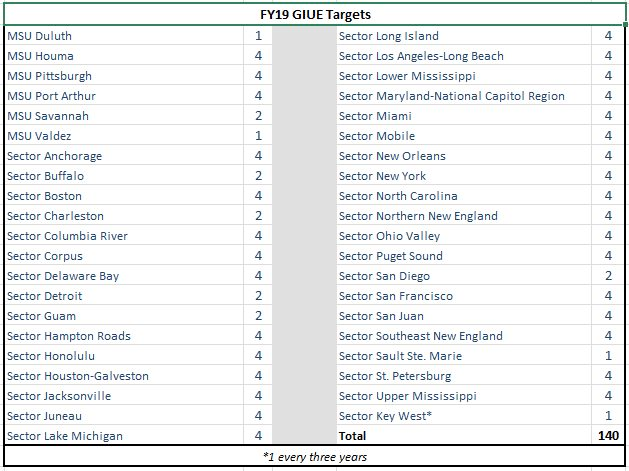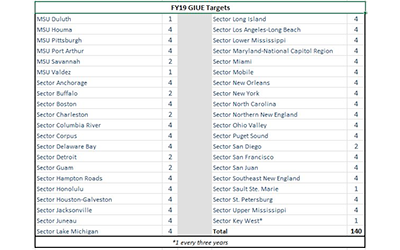Posted by LT Amy Midgett, Friday, October 5, 2018, Coast Guard Commons
The Coast Guard on Sept. 25, 2018 published the FY19 Government Initiated Unannounced Exercise (GIUE) requirements for each Captain of the Port zone, sector, and marine safety unit, in accordance with the maximum number of GIUEs permitted under regulation and the National Preparedness for Response Exercise Program Guidelines. In 2015, the Office of Marine Environmental Response Policy (CG-MER) reinvigorated the Coast Guard GIUE program by releasing new GIUE policy that has since been incorporated into the Marine Environmental Response and Preparedness Manual. This policy established consistent exercise design, execution and documentation across the Coast Guard. It also defined the number of GIUEs required at each unit.

GIUEs are a cornerstone of the oil spill exercise cycle and a key tool for Captains of the Port to evaluate oil spill response preparedness. One of the key benefits of the GIUE program is the ability for Captains of the Port to identify their biggest risks and apply a structured average most probable discharge (AMPD) exercise to analyze the plan holder’s capabilities.
Due to the complexity of responding to non-floating oils, CG-MER is establishing a workgroup to assess the feasibility and policy for GIUEs that test Group V petroleum oil facilities. Plan holders will not be tested on their ability to respond to a Group V oil until new policy is published.
Requirements for AMPD equipment are defined in 33 C.F.R. § 154.1045(c) and 33 C.F.R. § 155.1050(d). Plan holders do not meet these requirements by merely staging the equipment onsite. One of the exercises that plan holder’s receive credit for is an equipment deployment exercise. Therefore, this equipment should be observed in an operational state. Containment boom, along with all necessary equipment for proper deployment, are to be in place within one hour and skimming device, including temporary storage, within two hours. Keep in mind that these are planning standards and that some time variance may be granted.
Coordinating GIUEs with other agencies benefits both plan holders and governing agencies alike. Joint GIUEs are a success story as they achieve the goals of testing industry, improve interagency relations and provide training opportunities, while concurrently reducing industry’s exercise burden. It is a priority for Coast Guard units to conduct joint exercises with partner federal, state, and local agencies when possible.
This Article was originally published at http://mariners.coastguard.dodlive.mil/2018/10/05/10-5-2018-fy19-requirements-for-govt-initiated-unannounced-exercises/

